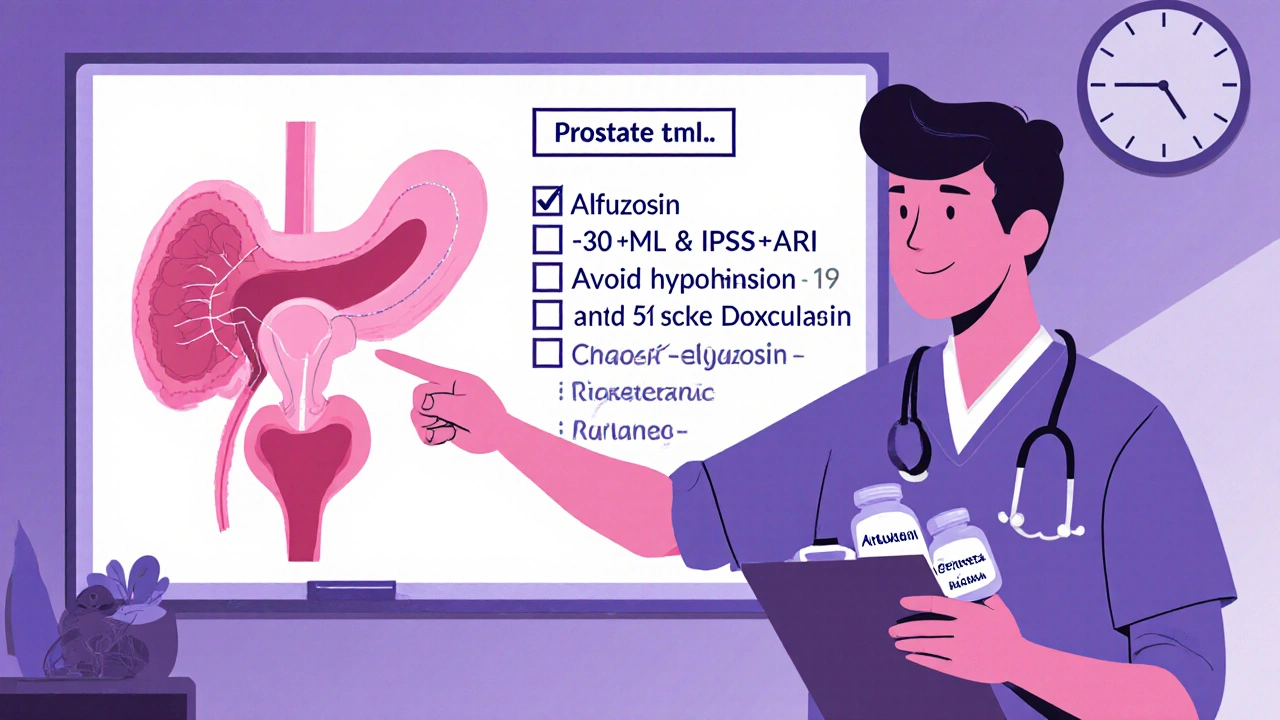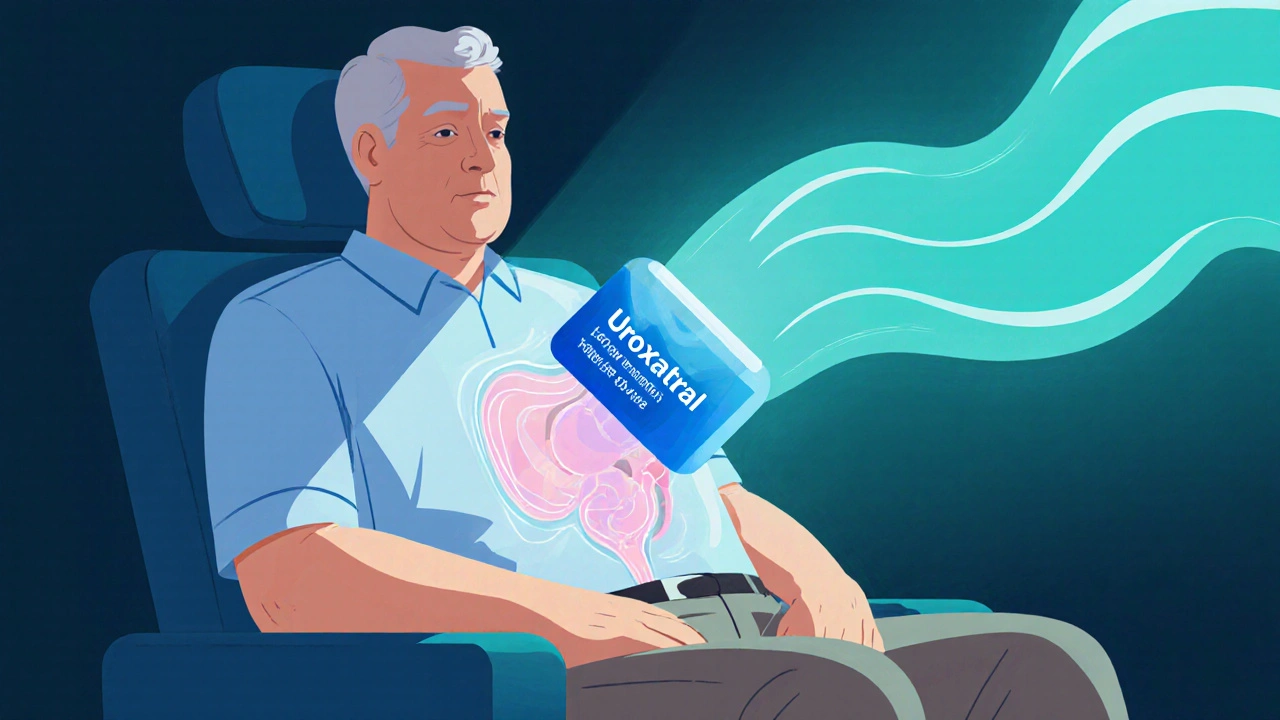BPH Medication Decision Tool
BPH Medication Decision Tool
This tool helps determine the most appropriate BPH medication based on your prostate size, symptom severity, and personal health factors.
Normal size: 20-30 mL, Moderate: 30-50 mL, Large: >50 mL
Quick Takeaways
- Uroxatral (alfuzosin) is an alpha‑blocker that eases urine flow without affecting sexual function for most men.
- It works best for mild‑to‑moderate BPH, but may need combination therapy with a 5‑alpha‑reductase inhibitor for larger prostates.
- Common alternatives - tamsulosin, silodosin and doxazosin - share the same class but differ in dosing frequency and side‑effect profiles.
- Finasteride and dutasteride shrink the prostate over months but can cause sexual side effects and require regular PSA monitoring.
- Choosing the right drug depends on prostate size, symptom severity, cardiovascular health, and personal tolerance for side effects.
What Is Alfuzosin?
Alfuzosin is an oral alpha‑blocker approved for the treatment of benign prostatic hyperplasia (BPH). It relaxes the smooth muscle in the bladder neck and prostate, improving urine flow without significantly affecting blood pressure. The brand name Uroxatral is the most common formulation in Australia, taken once daily after a meal.
Understanding Benign Prostatic Hyperplasia (BPH)
Benign Prostatic Hyperplasia (BPH) is a non‑cancerous enlargement of the prostate gland that affects up to 50 % of men over 60. Enlarged tissue compresses the urethra, causing urinary frequency, urgency, weak stream, and nocturia. The condition is progressive, but symptom severity varies widely.
How Alpha‑Blockers Work
All alpha‑blockers, including alfuzosin, target the α1‑adrenergic receptors in prostatic smooth muscle. By inhibiting these receptors, they prevent muscle contraction and reduce outlet resistance. This class offers rapid symptom relief-often within days-making them first‑line for many patients.
Key Alternatives to Alfuzosin
Below are the most commonly prescribed alternatives, grouped by drug class.
- Tamsulosin another selective α1‑blocker that’s taken once daily, often at bedtime.
- Silodosin highly selective for the α1A subtype, reducing the risk of blood‑pressure drops.
- Doxazosin a non‑selective α1‑blocker that can be used for both BPH and hypertension.
In addition to alpha‑blockers, 5‑alpha‑reductase inhibitors (5‑ARIs) shrink the prostate over time:
- Finasteride blocks the conversion of testosterone to dihydrotestosterone (DHT), reducing prostate volume.
- Dutasteride inhibits both type 1 and type 2 5‑alpha‑reductase enzymes, offering a stronger volume reduction.
Side‑Effect Landscape
Understanding side effects helps you match a drug to a patient’s lifestyle.
| Drug | Typical Side Effects | Special Considerations |
|---|---|---|
| Alfuzosin (Uroxatral) | Dizziness, headache, abdominal discomfort | Low risk of intra‑operative floppy iris syndrome; safe with most antihypertensives |
| Tamsulosin | Ejaculatory dysfunction (up to 30 %), dizziness | Can trigger intra‑operative floppy iris syndrome - inform surgeons |
| Silodosin | Retrograde ejaculation, mild GI upset | Highly selective, minimal blood‑pressure effect |
| Doxazosin | Hypotension, dizziness, fatigue | Beneficial for patients with hypertension |
| Finasteride | Decreased libido, erectile dysfunction, breast tenderness | Requires PSA monitoring; may reduce prostate‑specific antigen levels |
| Dutasteride | Similar to finasteride but higher incidence of sexual side effects | Longer half‑life; may take up to 6 months for symptom improvement |
When to Choose Alfuzosin Over Others
Alfuzosin shines in several scenarios:
- Patients need rapid relief (within days) but have a moderate prostate size (<30 mL).
- Co‑existing cardiovascular disease limits the use of non‑selective blockers like doxazosin.
- Concern about sexual side effects makes alfuzosin attractive, as it has the lowest reported rate of ejaculatory dysfunction among alpha‑blockers.
- There’s a need for a once‑daily regimen that can be taken with food to improve adherence.
Combination Therapy: Alfuzosin + 5‑ARI
For men with larger prostates (>40 mL) or rapidly progressing symptoms, guidelines recommend adding a 5‑alpha‑reductase inhibitor to an alpha‑blocker. The combo reduces acute urinary retention risk by up to 30 % and can shrink the gland over 6-12 months.
Typical regimen: Alfuzosin 10 mg once daily plus Finasteride 5 mg daily. Monitor PSA every 6 months and reassess symptom scores (IPSS) after one year.

Cost & Accessibility in Australia (2025)
As of October 2025, the PBS lists both alfuzosin (Uroxatral) and tamsulosin at comparable subsidised prices, roughly AU$30 per month for a standard pack. Doxazosin, being older, is often cheaper but may require a private script if not covered for hypertension. 5‑ARIs sit slightly higher, especially dutasteride, which is not fully PBS‑listed for BPH alone.
Practical Decision Checklist
- Prostate size < 30 mL? → Start with an alpha‑blocker (alfuzosin, tamsulosin, silodosin).
- Prostate size ≥ 30 mL AND IPSS > 19? → Consider adding a 5‑ARI.
- History of orthostatic hypotension? → Prefer alfuzosin or silodosin over doxazosin.
- Concern about ejaculation? → Choose alfuzosin; avoid tamsulosin and silodosin.
- Need for blood‑pressure control? → Doxazosin can kill two birds with one stone.
Frequently Asked Questions
How long does it take for alfuzosin to improve urinary symptoms?
Most men notice a smoother stream within 3-5 days, though full benefit may take up to two weeks.
Can I take alfuzosin with other blood‑pressure medicines?
Yes. Alfuzosin is selective for prostate tissue and rarely lowers systemic blood pressure, so it’s generally safe with ACE inhibitors, beta‑blockers, or calcium‑channel blockers. Always check with a doctor.
What is the risk of intra‑operative floppy iris syndrome (IFIS) with alfuzosin?
IFIS is strongly linked to tamsulosin and silodosin. Alfuzosin carries a negligible risk, making it the preferred choice before eye surgery.
Should I stop alfuzosin before a cataract operation?
No stop‑over is needed for alfuzosin because it does not contribute to IFIS. However, disclose all medications to your ophthalmologist.
Is it safe to combine alfuzosin with finasteride?
The combination is standard practice and well‑tolerated. Monitor blood pressure and PSA; adjust doses if dizziness occurs.
Bottom Line
If you need quick symptom relief, a moderate‑sized prostate, and want to keep sexual function intact, Uroxatral (alfuzosin) is often the best single‑agent choice. For larger glands or when long‑term shrinkage is desired, add a 5‑ARI or switch to a different alpha‑blocker based on cardiovascular profile. Always discuss personal health history with a urologist to fine‑tune the regimen.



Erin Leach
October 26, 2025 at 11:10I can totally relate to the frustration of picking the right BPH med. Alfuzosin feels like a solid middle ground if you want quick relief without the sexual side‑effects that many guys dread. Just remember to take it after a meal and keep an eye on any dizziness.
Erik Redli
October 31, 2025 at 02:17This whole comparison reads like a marketing brochure. All those “benefits” are just hype, and the side‑effect tables ignore the real‑world dropout rates. I’d say stick to what the urologist actually prescribed, not a Reddit‑style cheat sheet.
Jennyfer Collin
November 4, 2025 at 17:24It is noteworthy that the pharmaceutical industry often under‑states the prevalence of post‑ural events associated with alpha‑blockers, especially when large consortia lobby for favorable labeling. One must consider the possibility that undisclosed data regarding chronic cardiovascular interactions are being deliberately omitted. The emphasis on “fast relief” may mask a longer‑term strategy to lock patients into lifelong medication cycles.
Tim Waghorn
November 10, 2025 at 12:17The pharmacodynamic profile of alfuzosin warrants a careful appraisal in the context of benign prostatic hyperplasia management. Alfuzosin exerts its therapeutic effect by antagonizing α1‑adrenergic receptors localized predominantly within prostatic smooth muscle. This receptor blockade reduces urethral resistance, thereby facilitating an improved urinary stream. Clinical trials have demonstrated that symptomatic relief can be observed within three to five days of initiating therapy. Nevertheless, maximal efficacy is typically reached after a fortnight, contingent upon patient adherence to the post‑prandial dosing schedule. The drug’s selectivity minimizes systemic vasodilatory effects, which distinguishes it from non‑selective agents such as doxazosin. Consequently, alfuzosin is less likely to precipitate orthostatic hypotension in patients with comorbid hypertension. A notable advantage of alfuzosin pertains to its negligible association with intra‑operative floppy iris syndrome, a consideration for patients anticipating cataract surgery. However, clinicians should remain vigilant for the relatively common adverse events of dizziness, headache, and mild gastrointestinal discomfort. In terms of drug–drug interactions, alfuzosin can be co‑administered with most antihypertensive classes without necessitating dose adjustments. The concomitant use of 5‑alpha‑reductase inhibitors, such as finasteride, is supported by evidence indicating synergistic reduction in acute urinary retention risk. Monitoring of prostate‑specific antigen levels is advisable when combination therapy is employed, given the potential for PSA suppression. Cost considerations in the Australian PBS framework reveal that alfuzosin is competitively priced relative to tamsulosin, thereby enhancing its accessibility. Patient selection criteria should prioritize moderate prostate volume and the absence of severe cardiovascular comorbidities. Ultimately, alfuzosin constitutes a rational first‑line option for men seeking rapid symptomatic improvement while preserving sexual function.
Brady Johnson
November 13, 2025 at 23:37The so‑called “quick relief” narrative is nothing but a marketing ploy, and the underlying data reveal a staggering 27% discontinuation rate due to intolerable dizziness. If you’re not prepared to be haunted by phantom headaches for weeks, consider the darker side of this drug that the article conveniently omits. This isn’t just a minor inconvenience; it’s a cascading cascade of physiological stress that could exacerbate existing comorbidities. In short, think twice before you let a pharma‑sponsored brochure dictate your prescription.
Dave Sykes
November 17, 2025 at 10:57Let’s keep perspective – most patients tolerate alfuzosin just fine, and the benefits often outweigh those transient side‑effects. If dizziness spikes, advise taking the dose with a larger meal or adjusting the timing to evenings. Encourage regular follow‑ups to monitor blood pressure and symptom scores. Staying proactive with lifestyle tweaks, like reduced caffeine, can also smooth the transition. Keep the communication open with your urologist, and you’ll navigate the adjustment period successfully.
Jay Campbell
November 19, 2025 at 18:30I appreciate the thorough breakdown and think it’s a solid starting point for anyone trying to decide between alpha‑blockers. It’s helpful to have the checklist laid out so readers can match their health profile to the right medication.
Laura Hibbard
November 22, 2025 at 02:04Sure, because everyone’s life is a simple checklist, right? But seriously, the “one‑size‑fits‑none” approach works better than endless tables for most of us.
Rachel Zack
November 23, 2025 at 05:50People should read the label befor they swallow any pills.
Lori Brown
November 24, 2025 at 09:37Great info! I feel more confident picking a med now 😊
Jacqui Bryant
November 25, 2025 at 13:24Take it slow, watch how you feel, and keep talking to your doctor. You’ve got this!
Paul Luxford
November 26, 2025 at 17:10This summary balances clinical detail with patient‑friendly language, making it a useful reference for both practitioners and patients alike.
Nic Floyd
November 27, 2025 at 20:57From a pharmacoeconomic perspective the cost‑benefit ratio of alfuzosin is favorable especially when you factor in reduced acute retention events – the data support a lower NNT compared to non‑selective agents 💊📈
Johnae Council
November 29, 2025 at 00:44Honestly this post reads like a sales pitch – half the facts feel cherry‑picked and the tone is way too polished for a real‑world discussion.
Manoj Kumar
November 30, 2025 at 04:30In the grand theatre of medicine, we all play actors juggling pills and promises – just make sure the script doesn’t forget the side‑effects.